Cover-up (tattoo)
People cover up old tattoos for a variety of reasons, such as that the tattoos were references to relationships that have ended, the tattoos were nonconsensual, or the tattoos relate to gangs or hate speech. Cover-ups after breakups have received particular attention due to high-profile cases involving celebrities. Cover-ups are one of the two main options of removing an unwanted tattoo, the other being laser removal. Covering up an unwanted tattoo is generally cheaper, less painful and an overall easier solution than tattoo removal.
A decorative cover-up tattoo can obscure a scar or skin condition with personally meaningful art, making it an alternative to more flesh-like paramedical tattoos. For example, in lieu of reconstruction post-mastectomy, a person may choose to get a decorative tattoo over their scars. Self-harm scars are another common target for cover-ups.
Both scars and old tattoo ink present additional challenges for a tattoo artist. Some tattoo artists specialize in cover-ups, and some give free cover-ups for cases such as hate symbols, human trafficking tattoos, and self-harm scars.
Contexts
Unwanted past tattoos
A person may seek a cover-up tattoo if they wish to distance themself from existing tattoos. The simplest reason is that they do not like how a tattoo appears on their body. In particular, cover-ups are associated with regret for the original tattoo. A 2013 study of tattoo removal and cover-up recipients found that regret often stems from dissatisfaction with the narrative that the tattoo represents, either due to the tattoo not being meaningful or to the symbolism being unsatisfying. Tattoo artists who do cover-ups are commonly asked to cover tattoos related to a person's past relationship. People also cover up tattoos related to non-romantic relationships, such as relatives from whom they have become estranged.
As tattoos grew more mainstream in the 1990s and even more in the 2000s, celebrity tattoos received significant attention, especially cover-ups of couples tattoos after breakups. After breaking up with actress Winona Ryder in 1993, actor Johnny Depp partially covered up a "Winona Forever" tattoo, to read "Wino Forever". Further notable post-breakup cover-ups include Denise Richards and Angelina Jolie.
Popular culture in the 2010s included further growth in the popularity of tattoos and coverage of celebrity cover-up tattoos. In 2017, influencer Kylie Jenner had her "T" for rapper Tyga changed to "LA" after their breakup. After marital separation in 2020, Nick Cannon replaced a large back tattoo of singer Mariah Carey's first name with a depiction of the crucifixion of Jesus. Comedian Pete Davidson and singer Ariana Grande got a combined 16 tattoos relating to each other before breaking off their engagement in 2018, then multiple cover-ups.
People also seek to cover up tattoos they received non-consensually. In the 17th century, the use of irezumi kei (penal tattoos) for prisoners in Japan fell out of practice largely because released prisoners would cover them up with decorative designs. Some sex trafficking victims who are subjected to branding tattoos later cover them up with chosen tattoos. In the United States and Canada, organizations including Survivor's Ink and Unbound facilitate such cover-ups.
Cover-ups can also be due to a change in what a person wants to be associated with, such as tattoos that convey religious views or connections to drugs or violence. A person may also not want to be associated with a particular work or artist; in one prominent example, many Harry Potter fans have covered tattoos related to the franchise due to author J. K. Rowling's views on transgender issues. Tattoos that represent hateful views or affiliation with criminal groups are a frequent subject of cover-ups. In the 1800s, prisoners on convict ships from Great Britain to Van Diemen's Land (Tasmania) sometimes "over-tattooed" old tattoos with new designs that defied state efforts to track their tattoos as identifying marks. Alphonse Bertillon's Signaletic Instructions, translated into English in 1896, contains instructions on identifying former prisoners who have had their tattoos "surcharged" (covered up) or removed. Due to rising anti-gang enforcement from the 1990s onwards, it has become increasingly common for gangsters to cover up their gang tattoos despite still being members.
Scars and skin conditions

The use of flesh-like medical tattoos to cover up skin conditions and surgical scars is a long-established practice, dating to the German doctor Pauli in 1835, who used mercury sulfide and white lead to tattoo over skin lesions including nevi and purple plaque, or even to Galen, who executed tattoos of sorts over corneal opacities in 150 CE.
In the 21st century, decorative cover-up tattoos became a more popular approach to obscuring scars, including burns, self-harm scars, surgical scars, and stretch marks. In cases of scars that are hyperpigmented, uneven in texture, or cover a large area, it is often not possible to restore the flesh's previous appearance; decorative tattoos serve to either cover or camouflage these scars instead. A 2008 case report, one of the first medical articles on the subject, noted patients taking the initiative in receiving decorative cover-ups. In the early 2010s, decorative tattoos emerged as a trend after breast cancer–related mastectomy, particularly in the United States. Some transmasculine people who receive mastectomies also opt for decorative cover-ups. A 2021 systematic review speculated that decorative scar concealment is one of the most common applications of medical tattooing in a cosmetic or reconstructive context, but noted a lack of evidence, perhaps because many such tattoos happen at the patient's initiative rather than through a medical provider.
